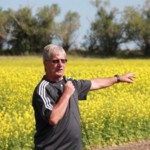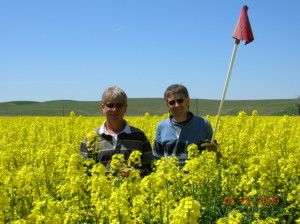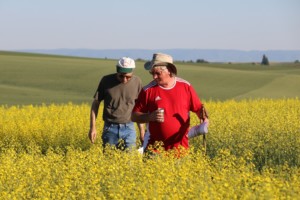 By Jack Brown, Ph.D.
By Jack Brown, Ph.D.
The University of Idaho (UI) oilseed research group has a long history of agronomic research. It started developing canola cultivars before the crop was approved as Generally Recognized as Safe (GRAS) by the U.S. Food and Drug Association in 1985.
 Thirty years ago, I was appointed to lead the UI canola research and breeding group. The first thing I did was appoint researcher Jim Davis, who had a huge impact on Pacific Northwest (PNW) canola, rapeseed and mustard production. Hard to believe now, but in 1992, hardly a handful of canola acres were grown in the region; average canola yields were below 500 pounds per acre and the price of canola seed to farmers was $0.04 per pound. Now regional canola acreage exceeds 370,000 acres, average yields have increased four- to five-fold, canola prices exceed $0.35 per pound, and grower returns from canola equal or exceed the traditional winter wheat crops.
Thirty years ago, I was appointed to lead the UI canola research and breeding group. The first thing I did was appoint researcher Jim Davis, who had a huge impact on Pacific Northwest (PNW) canola, rapeseed and mustard production. Hard to believe now, but in 1992, hardly a handful of canola acres were grown in the region; average canola yields were below 500 pounds per acre and the price of canola seed to farmers was $0.04 per pound. Now regional canola acreage exceeds 370,000 acres, average yields have increased four- to five-fold, canola prices exceed $0.35 per pound, and grower returns from canola equal or exceed the traditional winter wheat crops.
But as of Sept. 30, 2022, an era ended for UI canola breeding and research because Jim retired from the university after over 30 years of working with canola, rapeseed and mustard.
 Since 1992, the emphasis of UI research has been to develop genetically superior Brassica oilseed and condiment mustard cultivars as well as cover (green manure) crops suitable for a wide range of environments throughout the PNW and other U.S. regions. It also focused on developing best management practices to maximize canola production.
Since 1992, the emphasis of UI research has been to develop genetically superior Brassica oilseed and condiment mustard cultivars as well as cover (green manure) crops suitable for a wide range of environments throughout the PNW and other U.S. regions. It also focused on developing best management practices to maximize canola production.
During Jim’s and my tenures (I retired two years ago), the breeding group commercially released five winter canola, two winter rapeseed, five spring canola, five spring rapeseed, three yellow mustard and five Indian mustard cultivars. Jim has headed regional agronomic research examining rotational benefits of canola with cereal crops and optimum production practices, including planting date, seeding rates, insect and disease management, pre-harvest and harvest techniques, and end-use quality. In addition, Jim was responsible for organizing the PNW’s winter and spring canola and mustard variety trials. These trials examine the production of potential accessions from UI, other commercial breeders and seed companies. They identify adapted cultivars by suitable growers from the varied environmental conditions across the region.
 The huge increase in canola and mustard production in the PNW is due to many factors, but Jim’s contribution is undeniable. With his retirement, an era will end. Recently, the UI completed interviewing three excellent candidates to replace my own faculty position. Once the new appointment is finalized, a new era will begin.
The huge increase in canola and mustard production in the PNW is due to many factors, but Jim’s contribution is undeniable. With his retirement, an era will end. Recently, the UI completed interviewing three excellent candidates to replace my own faculty position. Once the new appointment is finalized, a new era will begin.
Jack Brown, Ph.D., is professor emeritus of plant breeding at the University of Idaho in Moscow, Idaho.